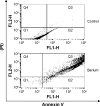Nanoparticles of barium induce apoptosis in human phagocytes
- PMID: 26451108
- PMCID: PMC4592030
- DOI: 10.2147/IJN.S90382
Nanoparticles of barium induce apoptosis in human phagocytes
Abstract
Purpose: Nutrients and immunological factors of breast milk are essential for newborn growth and the development of their immune system, but this secretion can contain organic and inorganic toxins such as barium. Colostrum contamination with barium is an important issue to investigate because this naturally occurring element is also associated with human activity and industrial pollution. The study evaluated the administration of barium nanoparticles to colostrum, assessing the viability and functional activity of colostral mononuclear phagocytes.
Methods: Colostrum was collected from 24 clinically healthy women (aged 18-35 years). Cell viability, superoxide release, intracellular Ca(2+) release, and phagocyte apoptosis were analyzed in the samples.
Results: Treatment with barium lowered mononuclear phagocyte viability, increased superoxide release, and reduced intracellular calcium release. In addition, barium increased cell death by apoptosis.
Conclusion: These data suggest that nanoparticles of barium in colostrum are toxic to cells, showing the importance of avoiding exposure to this element.
Keywords: barium chloride; colostrum; immune cells; immunotoxicology; intracellular Ca2+.
Figures



Similar articles
-
Melatonin Action on the Activity of Phagocytes from the Colostrum of Obese Women.Medicina (Kaunas). 2019 Sep 23;55(10):625. doi: 10.3390/medicina55100625. Medicina (Kaunas). 2019. PMID: 31548499 Free PMC article.
-
Antioxidant effect of melatonin on the functional activity of colostral phagocytes in diabetic women.PLoS One. 2013;8(2):e56915. doi: 10.1371/journal.pone.0056915. Epub 2013 Feb 20. PLoS One. 2013. PMID: 23437270 Free PMC article.
-
Human colostral phagocytes eliminate enterotoxigenic Escherichia coli opsonized by colostrum supernatant.J Microbiol Immunol Infect. 2011 Feb;44(1):1-7. doi: 10.1016/j.jmii.2011.01.002. Epub 2011 Jan 12. J Microbiol Immunol Infect. 2011. PMID: 21531345
-
The role of cytokines in the functional activity of phagocytes in blood and colostrum of diabetic mothers.Clin Dev Immunol. 2013;2013:590190. doi: 10.1155/2013/590190. Epub 2013 Dec 17. Clin Dev Immunol. 2013. PMID: 24489577 Free PMC article.
-
[Human colostrum and milk cells].Rev Paul Med. 1991 Sep-Oct;109(5):225-31. Rev Paul Med. 1991. PMID: 1821068 Review. Portuguese.
Cited by
-
Melatonin Action on the Activity of Phagocytes from the Colostrum of Obese Women.Medicina (Kaunas). 2019 Sep 23;55(10):625. doi: 10.3390/medicina55100625. Medicina (Kaunas). 2019. PMID: 31548499 Free PMC article.
-
Incorporation of Barium Ions into Biomaterials: Dangerous Liaison or Potential Revolution?Materials (Basel). 2021 Oct 2;14(19):5772. doi: 10.3390/ma14195772. Materials (Basel). 2021. PMID: 34640168 Free PMC article. Review.
-
Macrophage Plasticity in Reproduction and Environmental Influences on Their Function.Front Immunol. 2021 Jan 14;11:607328. doi: 10.3389/fimmu.2020.607328. eCollection 2020. Front Immunol. 2021. PMID: 33519817 Free PMC article. Review.
-
Genome-wide transcriptional analysis of silica nanoparticle-induced toxicity in zebrafish embryos.Toxicol Res (Camb). 2016 Jan 20;5(2):609-620. doi: 10.1039/c5tx00383k. eCollection 2016 Mar 1. Toxicol Res (Camb). 2016. PMID: 30090375 Free PMC article.
-
Role of pH and Crosslinking Ions on Cell Viability and Metabolic Activity in Alginate-Gelatin 3D Prints.Gels. 2023 Oct 27;9(11):853. doi: 10.3390/gels9110853. Gels. 2023. PMID: 37998943 Free PMC article.
References
-
- Field CJ. The immunological components of human milk and their effect on immune development in infants. Am Soc Nutr Sci. 2005;135:1–4. - PubMed
-
- Hanson LA. Session 1: feeding and infant development breast-feeding and immune function. Proc Nutr Soc. 2007;66:384–396. - PubMed
-
- Chirico G, Marzollo R, Cortinovis S, Fonte C, Gasparoni A. Antiinfective properties of human milk. J Nutr. 2008;138:1801S–1806S. - PubMed
-
- França EL, Nicomedes TR, Calderon IMP, Honorio-França AC. Time-dependent alterations of soluble and cellular components in human milk. Biol Rhythm Res. 2010;41:543–547.
Publication types
MeSH terms
Substances
LinkOut - more resources
Full Text Sources
Miscellaneous

